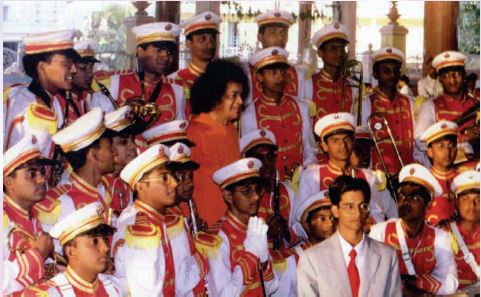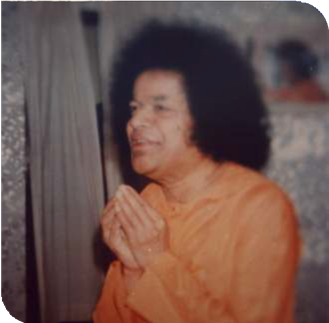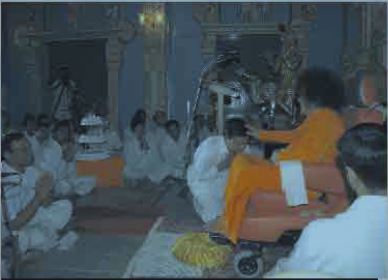by Dr.S.Kumar
(The narrative tense of this article has been modified to enable readers to experience the happenings live)
It is 1985, and hectic plans are afoot for Swami’s 60′ birthday celebrations later in the year. It is now two weeks before Ugadi, and Bhagawan calls five of us music boys into the Parthi interview room. We are expectedly excited. He begins by asking us what we have planned for the Ugadi celebrations. We tell Swami we have planned a music program for the morning, even though we had not really worked out the details! Bhagawan takes us at our word and says ‘Hmmm. Start singing the songs. Oh my – we are caught on the wrong foot! We sheepishly mumble that we have not finalized the song selection as yet. I brace myself for a chiding from Swami. Maybe we should have short listed songs by now? I am pleasantly surprised when I hear Swami say “Aithe mari nenu meeku pata nerpithe padagalara? Ayo papam time yekkuva ledu!” (Oh! Then if l were to teach you some songs, will you be able to sing these? There isn’t much time though – is there?!) His voice is dripping with concern. We respond in unison with a resounding yes to Swami’s question, jumping at the opportunity to learn from Him. I sigh with relief, at the same time can’t help marveling at Swami’s kindness in letting us off.
Swami now says, “I shall teach you two songs…I want this song to be your first song for the program.” Then He asks – “Guess which language I’ve composed it in?”
Since it is the Ugadi festival we are discussing, we confidently say “Swami- Telugu!” Swami says ·” No”. So one of us ventures to say ‘Kannada’, while another says ‘Sanskrit, Swami’, but all our guesses turn out to be wrong. We finally get the point and keep silent.
Then to our amazement, Swami starts singing a song He has composed in Tamil. I am really surprised because the Tamil almanac is different from those followed in Andhra, Karnataka or Maharashtra – in fact the Ugadi festival does not even find a spot in the Tamil calendar!
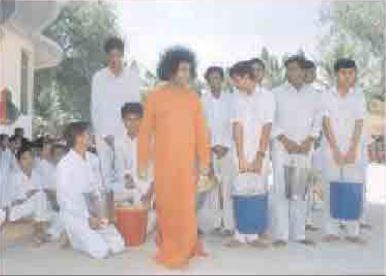
Minutes into our singing lesson, and He has already taught us that He is beyond the bounds of regions and languages. The song itself is composed in Raag Sankarabharanam – C Major in the western notation, the most basic of starter scales. Swami sings the first six lines of the song ”Indre Subha Diname… ” (Today is a holy day..) in Tamil. Then, almost as if to please the other students in the room, He adds a few more lines in other languages, impromptu – Telugu, Kannada, Hindi, English…and makes us learn the song by repeating after Him, line by line. What a feeling! I am thrilled.
At the end of the session, Swami briefly tells us that we could sing this song on any day and subtly defines God as the one who is ever fresh – ever new!
As the first song concludes, just as a school teacher would make the sample problems easy and then save the tougher ones for later, Swami shifts gears in the lesson plan saying, “Now, the second song will be in Telugu. It is in Todi Raagam Jhaapaka Taalam (one of the more complex ragas and tougher rhythms in Carnatic music). The song runs” Yela Nirasha Sayeeshudunga, Partheeshudandaga” (Why fear when Sai is here, the Partheesha is just with you here, with you students…). It is as if the Lord has taken the pretext of teaching us this song to give us a tutorial on the technical nuances of this raga and the complex seven matra tala. We genuflect as He elaborates to us in His inimitable simplicity, the profundity of the lyrics that He has penned. I see Him deftly unfolding before us His supreme command over all aspects of the medium of expression I most love – music.
It is now a few months later in August. Swami comes for the regular afternoon Darshan on a Saturday, wafting over the sands like the evening breeze He does not call any devotees for interview. He comes instead to the bhajan hall and calls a few music boys including myself along with some senior students of the college.
Swami steps inside the kitchen and reappears a few minutes later along with Subbappayya, and right behind are some sweets and snacks for us. I immediately sense there is something special awaiting us that evening.
Swami announces that He is planning to have the Institute boys enact a drama that He has written, directed and acted in, earlier in His childhood. We all immediately assume that the play is Cheppinatlu Chesthara- a popular drama written by Swami in His childhood days.
Swami smiles and says He isn’t going to reveal the title of the drama until a day before it is to be performed. He mentions that it pertains to Radha’s devotion for Lord Krishna. So we are wrong again! At the same time, we can’t help wonder – ‘Wouldn’t a play about Radha have feminine roles? How would these be enacted by students from our campus?’ There are no immediate answers to this question. We wait expectantly for details.
Swami breaks the silence, mischievously tiptoeing around the unspoken question- “This play has many songs and we need a singer to play the role of Radha” By now, we are all getting a little anxious, and then He moves the topic to discussing the cast for different roles, Swami quickly announces the lead roles for Radha, Krishna, Satyabhama, Rukmini and Narada.
I am utterly stupefied to learn that Swami has chosen me for the lead role of Radha in the drama! My attention to what is happening around me blurs a little as my emotions oscillate between the elation of being handpicked by Him for a lead role on one hand, and doubts about my own ability to enact Radha’s role on the other.
I set aside these thoughts for the moment and realize He has moved on to narrating the screenplay scene by scene. He adds that the remaining roles for men and women from Repalle village could be identified later over a period of time.
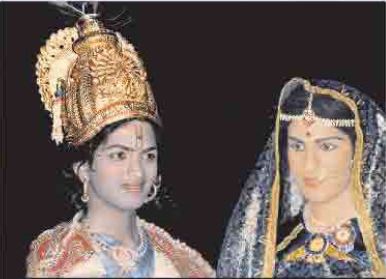
The next day is a Sunday, and so we students go in for morning darshan. Swami calls me to the interview room knowing, as always, the churn in my head. He is concerned and asks me if I am comfortable with acting as Radha in this play. Like a parent preparing His child for the first day in school, He underscores the credits of playing this role. He assuages my insecurity by asserting that He would spend much time with me everyday teaching me how to act, sing and dance. He cautions me to disregard the taunts that I might receive from the other six hundred boys in the hostel. My mind opens up to facing my insecurities. I reassure myself saying if He has cast me as Radha, what better opportunity would I get to learn what He has come to teach mankind?
The performance is now three months away. In addition to the daily practice schedule, Swami calls us all and teaches me the relevant songs – there are about twenty-five-songs in the dance drama. Unmindful of my writing the Telugu songs in Tamil, Swami dictates the songs word-for-word, pausing to make sure I can finish penning the lyrics. Swami teaches me the dialogues that communicate the importance of Radha. He asks me to sing every line after Him until my rendition is satisfactory, and then moves on the next verse.
The great wisdom that Swami condenses and presents in the most palatable form is ever present at each of these sessions. Swami expands R A D H A as Radhaki Adhar Dhara Aradhana – the basis of Radha’s life was shedding tears of joy by singing the praise of Krishna always, He states. He coaxes us to portray this attribute of Radha in our acting.
Swami instructs me not to talk much, think of Krishna, and do my role well in the play. Every day for ninety days, He makes me sing the songs taught by Him each morning and evening. He makes daily visits to the college auditorium and audio-visual room to guide the music boys providing the accompaniment for the songs.
As the monsoon season slowly meanders to winter, the falsetto is taking its toll on my voice. The loving care given by a mother is so evident in Swami’s concern. Swami immediately materializes tablets for me and vibhuti too. He advises me to take a hot water shower to safeguard my voice.
Just as He had said, Swami provides the title of the drama on the penultimate day. Two days before His birthday, on November 21, 1985 the drama is presented before a wide audience as RADHA KRISHNA.
Swami personally visits the make-up room before the drama to give final touches to Radha’s costume and facial make up. Who else in this world knows how Radha actually looked, I muse. After the play is complete; Swami gives me a place to sit near His Lotus feet and tells me that the drama was very good (Chala bagundi). I am very touched by His appreciation. This is Swami, I realize. He just gives so much happiness to everyone! The soul filling opportunity to learn songs composed and taught by Him does not end there, but continues for the many subsequent years of my stay at Parthi.
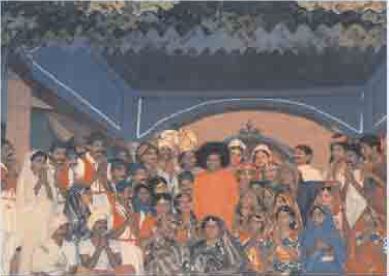
1991 is another important year in my life at the Lotus feet. Swami had once told me that He has a time and place for everything, and I know by now He is beyond time. It is after Rama Navami festival in March 1991. Swami is scheduled to leave for Brindavan. I have been talking to Swami in my own mind: “Swami! My PhD is nearing completion.
I now only need to write my thesis during summer and submit it for evaluation. I wonder how many more days You have in mind for my stay with You”. These thoughts tug at my heart, and I really don’t know what the future holds for me. Since Swami does not speak a word to me this morning and He is now all set to leave for Brindavan, I feel even more lonely. I decide to stay alone for some time. Just to have Swami’s darshan one-on-one, I keep walking from the Mandir and go past the boys’ hostel, the Gokulam, the arched gateway of Vidyagiri, and finally stop beyond the houses that follow – easily a kilometer from the hostel, right next to the fields. I stand under the shade of a lone tree- its leaves providing me my only company and protection under a bright sun. It is a lovely morning, but I couldn’t be more miserable.
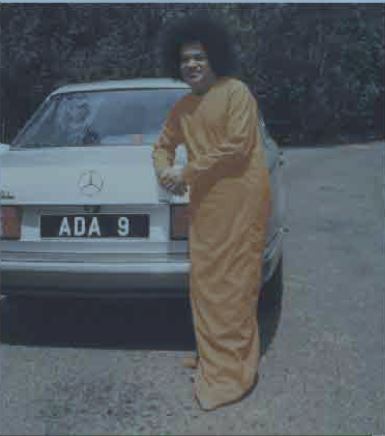
At 10.20 am, Bhagawan’s grey Mercedes ADA 9 shows up some distance away, along with loud shouts of Jai Jai Kar from the Gokulam. Swami’s car is the first car and is followed at least by a dozen designated cars and vans. The student driver is so kind that he is driving the car at the speed of 10 km per hour – slow enough to allow all the bystanders Swami’s darshan in slow motion. Swami’s car is fast approaching the spot where I stand.
I can feel my pulse racing as I step closer to the edge of the road to look at those lotus eyes. I peer closely through the closed window of the car’s rear seat where Swami is seated. Espying Swami and His halo from close, I feel so satisfied that I forget all about my PhD and my melancholy. Swami’s car passes me by. I crane my neck for a fast glimpse of the car – my heart is filled with the joy of having had close Darshan, nothing else. As I start to walk back, I suddenly notice that all the cars going behind Swami’s car have stopped. Even before I can understand what is happening, I hear someone calling me by name and running towards me.
As I turn, I see the caller is none other than the driver of Swami’s car – he has stopped the Mercedes on the road at a distance of ten cars from where I stand. He says that Swami is calling me urgently and asks me to run. I rush towards Swami’s car with some trepidation. Had I stepped too far away from the hostel limits in my desire for a quiet darshan? Is Swami displeased? Is he going to pull me up for breaking the discipline? Luckily, I have no time to resolve these thoughts as I find I am already looking once again at Swami’s form through the window of His car. Swami opens the car window with a press of a button, and I step closer. A cool whiff and the divine fragrance envelop me. I am tight-lipped, not knowing what lies in store. Swami’s first question is “When will your PhD be complete” “This summer, Swami” I reply meekly. “Then you do one thing, come to Kodaikanal with Swami”. There is no place in the bus. You come by van.” Swami’s words fall on my ears like manna from heaven. I am too dazed to respond! All I can do is to ask for pada namaskar. Swami stretches out His hand. I touch his fingers, and then the Window closes with another press of the power window button. I am rooted to the spot, staring at the fast receding caravan of cars. The only thing I realize is that the cool breeze is no longer brushing my face.
I am now on my way from Ooty to Kodai. From the van I am in, I notice Swami’s car stopping every now and again. Swami decides to take turns traveling with students in the bus and van, until we reach Kodaikanal. The only rule is that while students in the van could join the group in the bus whenever Swami steps into the bus, students in the bus cannot join the smaller group in the van! In the bus, we witness a touching and revealing miracle performed by Swami. In one of the small towns we are passing by, Swami tells the driver in advance that He would tell him where and when to stop the bus enroute. We continue singing songs and listening to Swami, when suddenly He states, “A few kilometers from here, you will find a petty-peanut mobile shop, run by a father and son. The father is blind and so he just sits in one place doing his job while the son goes around distributing peanuts to customers and collecting the money”. What a detailed description of a sight none of us can see, at a place we have not reached as yet!
We continue traveling, and I notice Swami does not look out of the bus at all! He continues conversing with us unconcerned about the scenes outside. It is clear to all of us that there was no one in the bus looking out for the father and son Swami spoke of. In about a half hour, Swami asks the driver to stop the bus. The driver stops immediately and pulls over to the left side of the road. We wait with bated breath. Out of nowhere, a boy approaches our bus and starts tapping the sheet metal below our windowpanes- in his hands he held peanuts to sell! We are excited – was this indeed the boy Swami said would come by more than half an hour ago, we wonder?
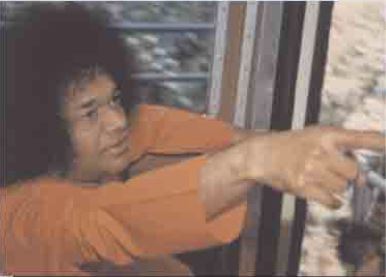
There is no way anyone could have known precisely where the mobile cart would be except for Swami, of course! One of the students gets down and buys peanuts – enough for Swami to hold and distribute to all of us as Prasadam. When the student offers the peanuts to Swami, He accepts it and then asks the little boy to bring his entire stock of peanuts for distribution to the students in the bus. The boy is further surprised when Swami asks him to bring his father along. When father and son arrive, Swami buys the entire stock of peanuts and touches the father’s head in blessing. After the doors of the bus close and we are on our way, Swami says- “The father of this peanut boy has been wanting to see GOD, but he is blind. That is why I touched his head.” I marvel at this opportunity for me to experience a fraction of the supreme power that He is.
Swami travels with the students in the van a few more times and speaks to us about the importance of Swami’s car. Swami points to His own car in front of the bus and says that all the devotees on the roadside are offering their namaskar to His car despite the fact that Swami is sitting with us in the Van. He asks a student seated -Why? The student keeps quiet. Swami answers saying “The car associated with Swami gets as much respect as Swami Himself. That is the power of Satsang”.
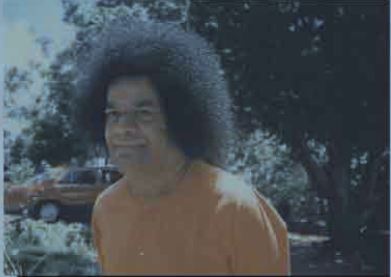
During this trip, Swami teaches me a Thyagaraja keerthana titled Rama Nannu Brovara. He spends more than half an hour improvising and making me learn the song. During this session, Swami communicates the difference between regular singing and singing with bhavam, or feeling. As a singer, this lesson is utterly invaluable to me. I feel at that point – “Swami, You have given us an education and taught us everything we ever needed to know, been the guiding light and God in our life. How can we ever spell our gratitude to you?”
| The author Dr. S.Kumar, is currently based in Washington, DC. He is employed as a Software Development Manager for a small business supporting National Institutes of Health (NIH) Contract at Washington DC. Dr Kumar joined Swami’s Institute in Prasanthi Nilayam in 1984 where he earned his M.Sc. in the Mathematics Program. He went on to earn his Ph.D. in Artificial Intelligence from the Department of Mathematics and Computer Science (DMACS), SSSIHL in 1992 and taught at the Institute from 1986 to 1993. He continues to serve Swami by being an active member of the South Bethesda Sai Centre at Washington, DC by conducting Bhajan workshops, composing songs and providing musical support dramas and skits enacted by the SSSE. |

